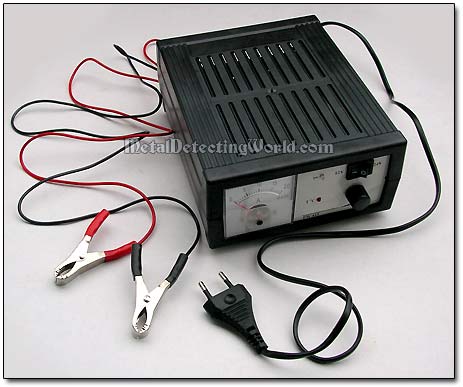Rust Removal with Electrolysis - a Detailed Illustrated Tutorial, page 8
2. How To Make a Simple Electrolysis Machine with a Car Battery Charger as DC Power Supply
To make a simple and effective electrolysis machine, you need the following components:
1) DC Power Supply
A direct current (DC) power supply provides the energy necessary to create or discharge the ions in the electrolyte. Unlike the electrolytic cleaning of coins and jewelry, the electrolytic rust removal requires more electric current to get the job done, especially when large iron objects are to be de-rusted. In this case, a common DC 12V adapter will not be sufficient, and a stronger DC power supply with higher voltage/amperage output is required.
A regular car battery charger best serves the purpose. Various car battery chargers are used by archaeologists and relic hunters for electrolytic de-rusting of iron artifacts, and can be purchased at any auto-part store or electronics retailer.
Car Battery Charger

If you are going to use a car battery charger that has a timer, relay or charging rate device, you must remove or disable these devices to allow the charger to run continuously for electrolytic rust removal. Or you simply buy a charger that lacks those features. Also, make sure you do not purchase a car battery charger that will not start generating current in the electrolyte unless you use a battery along with it.
In Europe, I use a dual voltage 12V/24V car battery charger that has the following features and technical specifications:
• Suitable for regular and low maintenance 12/24 Volts DC batteries
• Also suitable for automotive electronic applications, electronic devices and electrical instruments (this charger does not have a timer, relay or charging rate device)
• Voltage input: 180-240 Volts AC (European); 60Hz-50Hz
• Charging voltage output: 0-15V in 12V mode, 0-30V in 24V mode
• Charging current: 0.4-20A in 12V mode, 0.4-15A in 24V mode
• Battery voltage: 12/24 Volts DC
• Fitted with ammeter, the amount of current is set up by a knob: 0 to 20A
• Fitted with voltage selector switch 12V/24V
• Fitted with cooling fan and protective circuit against overheating
• Designed for indoor use in temperature range from -10°C to +40°C
• Incorporates polarity and short-circuit protection
Some enthusiasts use car batteries or bench power supplies as DC power sources for electrolytic cleaning; however, one should be very careful with car batteries as they house a great deal of power and do not provide controlled current. It should be understood that current, not voltage, is the primary danger of electricity. Accidental short circuiting is the biggest danger when the electrodes accidentally touch one another.
 WARNING: Do not use "Wall Current", "House Current", or any type of AC mains current for electrolysis under any circumstances! Attempting to do so can kill you. And electrolysis will not work with AC current anyway.
WARNING: Do not use "Wall Current", "House Current", or any type of AC mains current for electrolysis under any circumstances! Attempting to do so can kill you. And electrolysis will not work with AC current anyway.
Since an electrolytic cell for cleaning artifacts lacks the resistance of a battery, and the battery chargers generally do not have the necessary internal resistance controls to compensate for it, the chargers run well above their maximum safe operating amperage. Remember, electrolysis depends on controlling the voltage and DC current (see details in the "Controlling Voltage and Current" section on page 23).
I found out from my experience that the electrolytic de-rusting of both small and large objects works best with 24 Volts DC. Any voltage above 24 Volts does not increase efficiency, and generally is wasted off as heat into the electrolyte. Heat is just a waste of electricity.